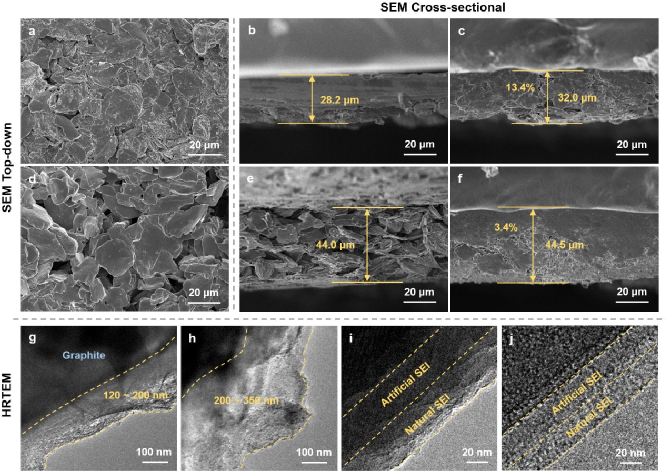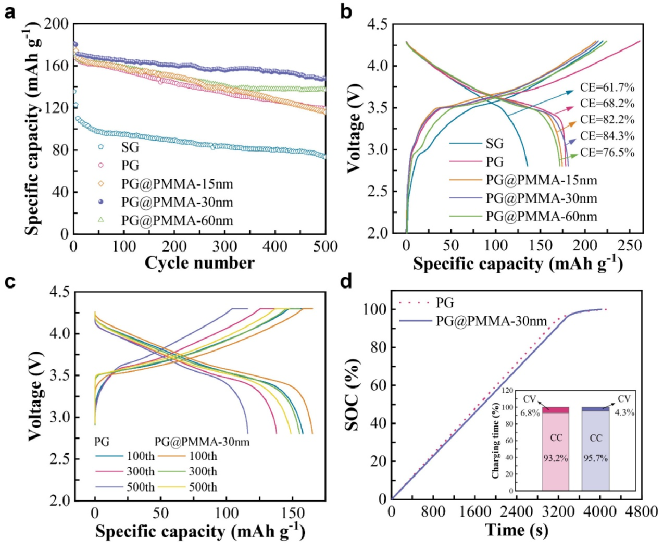

人工SEI层构筑用于废旧石墨负极表面结构修复与电化学性能再生
描述
【研究背景】
随着锂离子电池(LIBs)在减少温室气体排放和改善环境可持续性使命下被广泛使用,大量达到寿命终点的废旧LIBs将面临大量的积累。目前,只有不到5%的废旧LIBs得到了彻底再生利用。此外,目前废旧LIBs回收过程主要集中从正极中回收分离有价元素,如Li、Co、Ni等,同样具有相当成本的石墨负极回收再生过程被严重忽视。
石墨本体颗粒在经历长期锂化/脱锂过程后能够仍旧保持稳定层状结构,这表明其具有回收再生的可能性。然而,Li+长期往复嵌入/脱出过程造成了表面结构破损,导致电化学性能遭到严重受损。受损表面如若不进行包覆修复,所暴露结构缺陷将导致SEI的不规则生长,不可避免地消耗更多锂源储存,造成库伦效率下降并加速再生电池性能老化。因此,探索并开发出具有低成本的废旧石墨表面修复再生技术对于实现关键电池材料闭环供应极为重要。
【工作介绍】
近日,中国科学院过程工程研究所离子液体团队将甲基丙烯酸甲酯(MMA)通过低温聚合包覆在废旧石墨负极表面,形成了PMMA人工SEI层。在Li+连续嵌入/脱出过程中,内层人工SEI可以有效调节外层天然SEI沉积,从而形成稳定均一双层SEI结构。该双层SEI结构可以有效缓解EC基商业电解液的分解,防止天然SEI不规律生长及严重的锂源储存消耗。
通过TOF-SIMS以及AIMD模拟深入揭示了PMMA人工SEI层的表面修复再生机制。使用再生石墨所装配recycled graphite||NMC622全电池在1C下循环500圈后具有149 mAh g-1比容量,容量保持率高达86.7%。该文章以“Greatly recovered electrochemical performances of regenerated graphite anode enabled by an artificial PMMA solid electrolyte interphase layer”为题发表在国际著名期刊Energy Storage Materials上。中国科学院过程工程研究所博士研究生达昊然为本文第一作者。
【内容表述】
作者首先通过FTIR证实了PMMA与废旧石墨表面氧化官能团-OH相互作用,结合后由于PMMA中的酯基是一个强电子吸收基团,导致键力常数削弱而降低了-OH和C=C的振动频率。XRD图谱表明有机PMMA层的引入并不影响石墨本身晶体结构。Raman光谱结果显示PMMA人工SEI的引入将造成了整体结构无序化度增加,导致了PG@PMMA的AD/AG值部分下降。
XPS显示表面化学环境发生变化,包覆后C-O、C=O、COO相对于C-C的强度相比包覆前明显增加,表明PMMA人工SEI层在表面完全聚合形成。

Fig. 1. (a) Schematic of the preparation and functional mechanism of PG@PMMA through emulsion polymerization. The comparison of (b) FTIR spectra, (c) XRD patterns, (d) Raman spectra, (e, f) C 1s and (g, h) O 1s XPS spectra of pristine PG and the coated PG@PMMA.
经过系统除杂过程,纯化石墨(PG)表面暴露出干净的片层边缘结构和光滑的基底平面结构。聚合后,通过SEM可以观察到表面PMMA层的存在,对应TEM图显示了不同人工SEI包覆厚度。

Fig. 2. SEM (first row) and TEM (second and third row) images of (a, c) PG and (b) PG@PMMA with different thickness PMMA layer of (d) 15 nm, (e) 30 nm and (f) 60 nm. The amplified image in inset of (a, b) shows the surface details of the PG and PG@PMMA.
随后作者进一步探究了PMMA人工SEI层对再生石墨电化学性能影响。结果表明,包覆层厚度为30 nm下为最佳包覆厚度,表现出最优的循环稳定性和倍率性能,首圈库伦效率高达91.9%。GITT结果计算所得再生后DLi+(5.02×10–13至1.45×10–9)相比前DLi+(2.09×10–14至1.24×10–10)高出1-2个数量级,表明界面Li+扩散过程得到了有效增强。EIS结果显示界面传荷行为得到了明显改善。对其结果进行解耦,绘制了弛豫时间分布(DRT)曲线。
结果表明,再生后PG@PMMA-30nm中显示出五个特征峰,其分别归属于电荷转移反应(R4、R5)和Li+在SEI中传输行为(R1、R2、R3),其相比于PG所出现额外峰表明了人工SEI的形成。此外,γ表现出较小的数值,这表明界面反应过程得到了有效促进。PMMA人工SEI(1)有效缓解了循环过程中由于电解质还原所造成的自然SEI形成;(2)具有足够高的离子电导率和低的电子电导率,使得人工SEI在模拟实际SEI情况下实现良好的界面稳定性。

Fig. 3. (a) Cycling stability (performed at 0.1C), (b) GCD profiles (range of 0.01–2 V vs. Li/Li+), (c) rate performance (from 0.1C to 5C) of SG, PG, PG@PMMA-15 nm, PG@PMMA-30 nm and PG@PMMA-60 nm. GITT test of the (d) PG and (e) PG@PMMA-30 nm (discharge/charge state, inset figure shows the detail of circled area), and (f, g) their corresponding calculated diffusion coefficient plot. (h) Nyquist plots of the PG and PG@PMMA-30 nm (inner image) at selected cycles. (i) DRT plots of the AC-impedance results of PG and PG@PMMA-30 nm.
对循环后电池进行拆解,观察了电极和颗粒表面SEI形貌状态。PMMA人工SEI层存在可以显著抑制循环老化过程中电解质的持续还原与天然SEI的连续不规则生长,使得暴露表面结构更加稳定,所得双层结构能够牢固结合在一起,在表面形成均匀沉积层,经长期循环过程SEI厚度没有明显变化。

Fig. 4. SEI evolution of PG and PG@PMMA-30 nm after 5 cycles and 100 cycles. Top-down and cross-sectional SEM micrographs and corresponding HRTEM images of (a, b, c, g, h) PG and (d, e, f, i, j) PG@PMMA-30 nm after (b, e, g, i) 5 and (a, c, d, f, h, j) 100 cycles.
随后采用TOF-SIMS对双层SEI结构界面特征以及化学成分变化过程进行了深入探究。随着溅射时间增加,LiO2–、C2HO–、LiF–峰强度在初始和大约180秒时显示出两个峰值拐点,说明发生了两种不同化学物种的分化,证实了双层SEI的形成。3D渲染图和2D平面离子图谱进一步证实了不同物种碎片在表面均匀分布,表明双层SEI结构保持了整体结构稳定性。

Fig. 5. (a) Total integrated intensity of selected inorganic and organic fragments. (b) Negative-mode TOF-SIMS depth profiles of LiF–, LiO2–, C2HO–, C2H3O– as well as (c) their corresponding 3D renderings and (d) 2D ion mapping of PG@PMMA-30 nm electrode after 100 cycles. The TOF-SIMS sputtered area is 100 μm × 100 μm × 60 nm. (e) Schematic diagram of natural and artificial SEI formation on the surface of recycled graphite.
随后,通过AIMD模拟深入研究了PMMA人工SEI层对电解质分解的抑制作用机制。整个系统经历6 ps AIMD过程,在包覆PG表面,第一个EC分子在0-1000 fs内迅速断裂,第二个和第三个EC分子分别在大约1000-2000和2000-3000 fs内发生断裂,第四个EC分子在3000-4000 fs时间段发生断裂。在整个AIMD过程中,几乎观察不到EC分子的断裂。
此外,对Bader电荷每500 fs取一次平均值。结果表明,在裸石墨侧,C原子中电荷迅速从石墨表面转移到EC侧加速了EC分子的分解,与此同时,在与PMMA层接触时,从石墨侧到EC侧的电荷转移可以忽略不。因此,由PMMA所构筑的人工SEI层能够显著阻碍来自石墨界面的电荷转移过程,并有效减缓电解质的分解过程。

Fig. 6. Final time step of AIMD trajectory for EC on the surface of (a) bare graphite and (b) G@PMMA. (c) Number of broken EC molecules on the bare graphite and G@PMMA surface. (d) Charge transfer as a function of AIMD simulation time from the bare graphite surface to the exposed EC molecules and from the G@PMMA surface to the protected EC molecules.
在恒流-恒压(CC-CV)充电协议下对石墨||NMC622全电池进行测试,在整个循环过程中,使用无包覆层保护废旧石墨和纯化石墨负极的全电池表现出急剧的容量衰减,循环500圈后容量保持率仅为64.2%(73.5 mAh g–1)和68.7%(116.1 mAh g–1)。同样条件下,使用人工SEI保护最优条件下PG@PMMA-30nm负极全电池循环500圈后容量衰减轻微,容量保持率达到86.7%(149 mAh g–1)。恒流充电条件下,使用PG作为负极容量贡献为93.2%,而使用PG@PMMA-30作为负极容量贡献为95.7%。上述结果说明,预构筑PMMA人工SEI保护层可以有效改善界面性能,抑制电解质分解并显著提升再生石墨电化学性能。

Fig. 7. Cycling performance of recycled graphite||NMC622 full cells cycled over the voltage range 2.5–4.3 V vs. Li/Li+ at 0.1C for the initial 5 cycles and at 1C for the following cycles. (a) Capacity decay, (b) voltage profiles and ICE values of full cells with different treated graphite. (c) Charge/discharge curves at selected cycles. (d) SOC vs. time profiles of full cells with PG and PG@PMMA-30 nm anodes, the inset figure shows the relative contribution of CC charging and CV charging modes to the total charging time after 100 cycles.
Haoran Da, Shanshan Pan, Jin Li, Jiaqi Huang, Xuedi Yuan, Haotian Dong, Jiaxin Liu, Haitao Zhang*, Greatly recovered electrochemical performances of regenerated graphite anode enabled by an artificial PMMA solid electrolyte interphase layer, Energy Storage Materials 2023.
https://doi.org/10.1016/j.ensm.2023.01.038.
审核编辑 :李倩
-
高度复杂的电池电化学以设计高性能电池的主要障碍分析2022-12-14 2181
-
贮氢合金制备工艺对其电化学性能的影响2011-03-11 2173
-
金属材料的化学性能2017-08-25 2640
-
电化学原理介绍和分析方法2017-10-16 11697
-
应用电化学传感器的设计2018-11-15 2981
-
电化学传感器的发展怎么样?2020-03-25 3141
-
LabVIEW开发新型电化学性能测试设备2023-12-10 4176
-
表面包覆与改性掺杂对磷酸铁锂电化学性能简介2009-12-09 1120
-
Ag_AgCl电极的制备及电化学性能2012-02-22 2074
-
干货 | 锂电池正极材料理化性能和电化学性能的分析方法综述2019-07-30 15864
-
锂电池极片设计及表面缺陷对电池电化学性能的影响分析2022-11-01 3919
-
PCEE的双连续结构在优化其机械和电化学性能方面的作用2022-11-11 3598
-
锂离子电池的电极厚度对其电化学性能的影响2023-02-07 6316
-
涂覆PMMA层使回收石墨负极电化学性能得到极大恢复2023-03-13 3536
-
锂离子电池多孔电极的电化学性能研究2025-08-05 938
全部0条评论

快来发表一下你的评论吧 !

